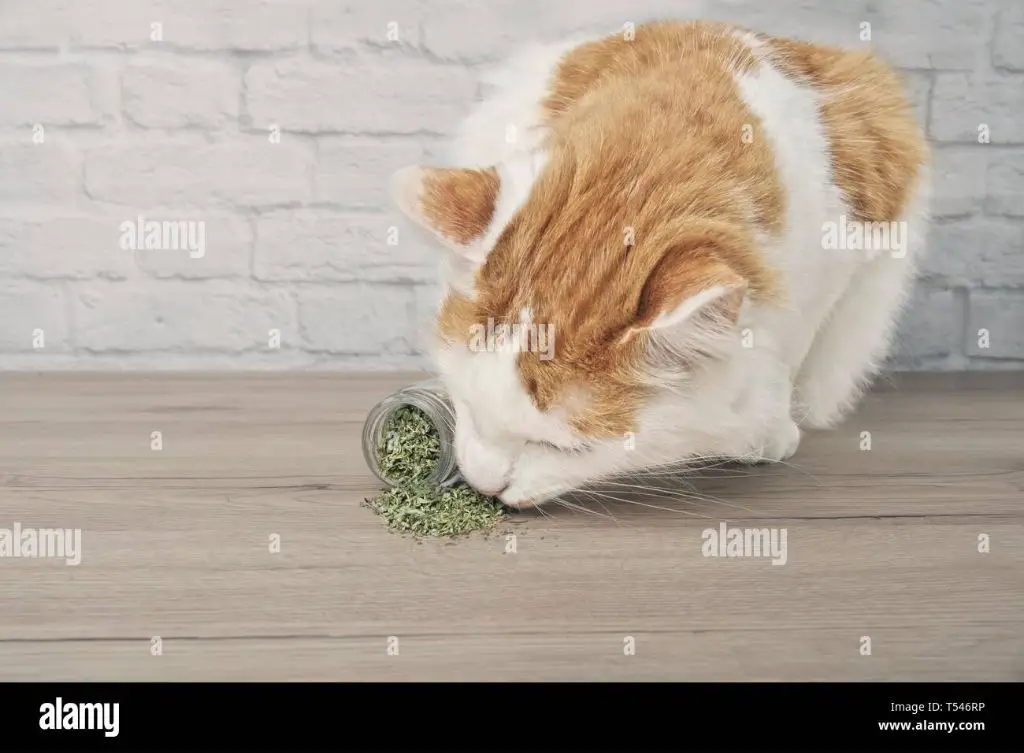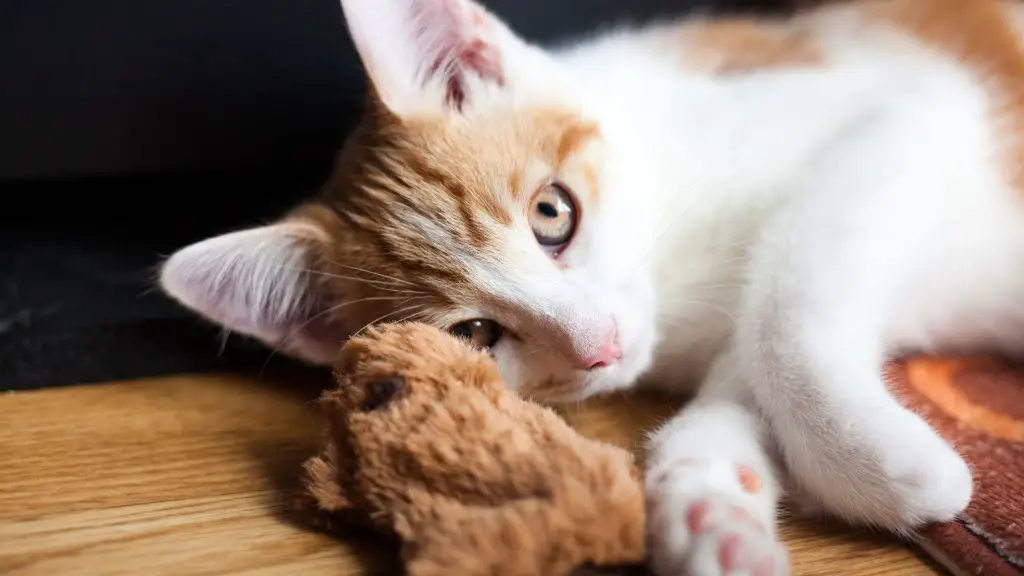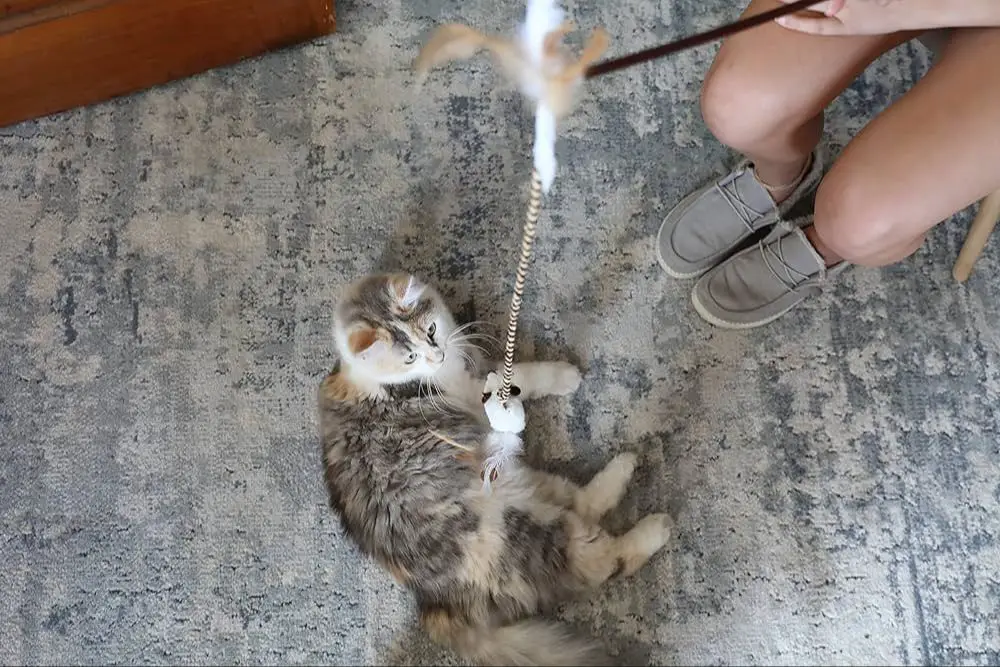What is catnip?
Catnip (Nepeta cataria) is a perennial herb that is a member of the mint family [1]. It is native to central and southern Europe, parts of the Middle East, Central Asia, and China. Catnip grows wild in many parts of North America as well.
The chemical compound that causes a euphoric reaction in cats is called nepetalactone. This volatile oil is found in the leaves and stems of the catnip plant. When cats smell or ingest nepetalactone, it binds to receptors in their noses and stimulates sensory neurons that trigger a response similar to the effects caused by some recreational drugs in humans [2].
Typical reactions in cats when exposed to catnip include rolling around, flipping over, rubbing against things, jumping, playing, vocalizing, and displaying a state of euphoria. The effects of catnip typically last around 5-15 minutes before wearing off.
Why do cats react to catnip?

Catnip contains an organic compound called nepetalactone which binds to olfactory receptors inside a cat’s nose. This binding stimulates feline sensory neurons to send signals to the brain which releases neurotransmitters like dopamine that induce the catnip response we observe in cats.
According to scientific research, when cats smell catnip, the nepetalactone enters the nasal tissue and binds to protein receptors specialized for nepetalactone. This stimulates the olfactory sensory neurons to send signals to the brain which leads to the release of neurotransmitters like dopamine. It’s the dopamine that causes the playful, excitable, and euphoric response we see when cats are exposed to catnip (Source).
Not all cats respond to catnip. Around 20-30% lack the genetic receptors necessary to bind nepetalactone and experience the catnip response. But those who do react do so because of this neurological pathway stimulated by catnip’s active compound nepetalactone.
Can dogs detect catnip?
Yes, dogs have a sense of smell that is 10,000 to 100,000 times more acute than humans thanks to having up to 300 million olfactory receptors in their noses compared to about 6 million in people (Source). So dogs can definitely detect the smell of catnip. However, they lack the same neurological receptors that cats have that makes them react to catnip (Source).
While dogs can pick up the smell of catnip, it does not appear to have the same euphoric effects in dogs as it does in cats because they lack those specialized receptors. But some dogs still seem to show interest in catnip, likely simply due to its strong aroma. The neurological reaction is different, even though they can detect the smell.

Why do some dogs react to catnip?
While cats are well-known to react strongly to catnip, dogs can also detect and respond to this plant. This is due to differences in individual dogs’ olfactory receptors. According to veterinarian Dr. Sara Ochoa, “dogs have a sense of smell that is 10,000 to 100,000 times more sensitive than humans” (source). So some dogs are able to pick up on and react to the nepetalactone compound in catnip.
Anecdotally, some dogs become hyperactive after being exposed to catnip. They may roll around, sniff excitedly, jump up and down, or playfully chase after cat toys filled with catnip. However, most dogs appear unaffected by catnip or may show mild interest without becoming overstimulated.
According to veterinarian Dr. Jerry Klein, “about 20 to 30 percent of dogs exposed to catnip will demonstrate a reaction” (source). So while many dogs can detect catnip through smell, only a fraction seem sensitive enough to exhibit behavioral changes from this herb.
In summary, a minority of dogs do react to catnip, likely based on individual differences in their olfactory receptors. But for most dogs, catnip does not induce the same excitable, catnip-crazed reaction seen in felines.
Is catnip safe for dogs?
Yes, catnip is considered safe for dogs when used appropriately. Catnip contains an oil called nepetalactone that is non-toxic for dogs and does not cause any serious adverse effects (source). While catnip will not harm your dog, some potential side effects include hyperactivity, anxiety, and an upset stomach if they eat too much catnip. As with any treat or supplement for dogs, catnip should be given in moderation.
Signs your dog is attracted to catnip
Some signs that indicate your dog may be attracted to catnip include:
Sniffing, licking, eating catnip: Dogs who are intrigued by catnip will often sniff it closely, lick and nibble on it, and even try to eat it. The strong scent of catnip gets their attention and makes them want to taste it (source).
Rolling in catnip: Some dogs may roll around in catnip, covering their bodies with it. Rubbing against and rolling in the catnip spreads its scent on their coat and allows them to absorb more of the essential oils from the plant (source).
Excitable behavior after exposure: While catnip has a relaxing effect on most dogs, some can become hyperactive after sniffing it. They may run around, jump, and play excitedly for 10-15 minutes before settling down (source).
Why your dog may like catnip
While catnip does not have the same strong effect on dogs as it does on cats, some dogs may still find the smell and taste of catnip intriguing. According to veterinarian Dr. Chyrle Bonk in an article on DailyPaws, catnip contains a chemical called nepetalactone that can mimic some appealing food smells to dogs like beef or chicken broth. So while catnip does not contain any nutrients dogs need, some may still find it irresistible due to its savory aroma [1].
Additionally, catnip can produce a mild altering effect on dog behavior because of how it binds to nasal receptors. As Dr. Bonk explains, catnip does not cause the same euphoric reaction in dogs as it does in cats, but some dogs may act mildly sedated or excitable after exposure. These behavior changes are temporary and not harmful.

Overall, the intriguing smell of catnip is the main reason why some dogs seem attracted to it. The aroma can mimic enticing food flavors they want to check out. Catnip also causes mild behavioral changes, but it does not make dogs “high” the way it does for cats.
Risks of dogs ingesting catnip
While catnip is generally considered safe for dogs, ingesting large quantities can pose some health risks. The main risks of dogs ingesting catnip include:
-
Upset stomach and diarrhea – Catnip contains nepetalactone which can irritate a dog’s digestive system. Consuming a large amount may cause vomiting, diarrhea or other stomach issues.[1]
-
Dehydration – Vomiting and diarrhea can quickly lead to dehydration in dogs. It’s important to monitor a dog closely after ingesting catnip and provide plenty of fresh water to prevent dehydration.
-
Interacts with other medications – The nepetalactone in catnip may interact with some medications like sedatives or immunosuppressants. Check with your vet before giving catnip if your dog takes any regular medications.[2]
While small amounts of catnip are unlikely to cause issues, it’s best to limit a dog’s exposure. Monitor your dog closely if they ingest catnip to watch for vomiting, diarrhea or other concerning symptoms. Contact your vet immediately if you have any concerns after your dog eats catnip.
Keeping your dog safe around catnip
While small amounts of catnip are not harmful for dogs, you’ll want to take some precautions around this tempting herb. Catnip can have a strong effect on some dogs, making them excitable or hyper. Large quantities may also cause vomiting or diarrhea in sensitive animals [1].
To keep your dog safe around catnip:
- Don’t let your dog ingest high quantities of catnip. Limit access to catnip plants or bags of dried leaves.
- Redirect your dog to chew on more appropriate toys if they try to eat catnip.
- Supervise your dog any time catnip is present to prevent overindulgence.
Taking basic precautions will allow your dog to safely enjoy catnip’s intriguing scent and flavor when given in moderation.
Satisfying your dog’s curiosity safely

While some dogs enjoy catnip, it’s important to satisfy their curiosity safely. Here are some tips:
Use catnip-free toys and treats. There are many toys and treats made specifically for dogs that don’t contain catnip. Rotating different toys will keep your dog entertained without exposing them to catnip.
Train a ‘leave it’ command. Teaching your dog to ‘leave it’ when you want them to stop interacting with something is a useful skill. Reward your dog for leaving catnip toys alone.
Allow limited supervised exposure. If your dog seems fascinated by catnip, you can allow them to sniff or lightly chew a catnip toy while you supervise. Limit access to 1-2 minutes then put the toy away securely.
The key is protecting your dog while satisfying their interest in a safe, controlled way. With training and the right toys, your dog can explore catnip from a distance without negative effects.

